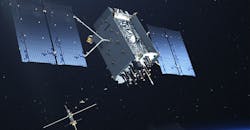The first GPS III satellite has been successfully launched to begin the next generation of the precision positioning system. The new satellite, developed by Lockheed Martin, is part of the U.S. Air Force’s plan to bring new technology and capabilities to the existing GPS constellation, in orbit at about 12,550 miles above the surface of the Earth. The satellite, known as GPS III Space Vehicle 01 (GPS III SV01), is receiving and responding to signals from Lockheed Martin’s Launch and Checkout Center in Denver after a launch from Cape Canaveral, Fla.
The GPS III satellite, nicknamed “Vespucci” by the U.S. Air Force after the Italian explorer Amerigo Vespucci, is claimed to have three times better accuracy than earlier GPS satellites, with longer operating lifetime. The satellite also promises improved connectivity for civilian users, with a new L1C civil signal that makes it the first GPS satellite to transmit signals compatible with other international global navigation satellite systems, such as the Galileo system used throughout Europe. Once it has been tested and found fully operational, it will take its place among the 31-satellite GPS constellation.
“In the coming days, GPS III SV01 will use its liquid apogee engines to climb into its operational orbit about 12,550 miles above the earth,” said Johnathon Caldwell, Lockheed Martin’s vice president for Navigation Systems. “We will then send it commands to deploy its solar arrays and antennas, and begin on-orbit checkout and tests, including extensive signals testing with our advanced navigation payload provided by Harris Corporation.
“This is the Air Force's first GPS III, so we are excited to begin on-orbit test and demonstrate its capabilities,” Caldwell added. “By this time next year, we expect to also have a second GPS III on orbit and users should be receiving signals from this first satellite.”
About the Author
Jack Browne
Technical Contributor
Jack Browne, Technical Contributor, has worked in technical publishing for over 30 years. He managed the content and production of three technical journals while at the American Institute of Physics, including Medical Physics and the Journal of Vacuum Science & Technology. He has been a Publisher and Editor for Penton Media, started the firm’s Wireless Symposium & Exhibition trade show in 1993, and currently serves as Technical Contributor for that company's Microwaves & RF magazine. Browne, who holds a BS in Mathematics from City College of New York and BA degrees in English and Philosophy from Fordham University, is a member of the IEEE.

